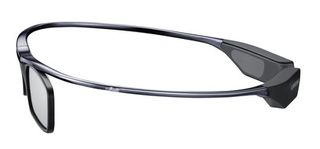Will polarised 3D TVs replace active shutter?
Why cheaper, passive 3D sets are on the rise

TOSHIBA: Toshiba's TL515 line-up of LED-backlit TVs will use polarised 3D tech, though the brand will also sell active shutter 3D TVs
Reviving passive - or natural - 3D technology is clearly an attempt to make 3D TVs much cheaper, but it comes at the cost of Full HD resolution. A problem?
"The perceived resolution is often similar because your brain adds it up," says Bill Foster at analysts Futuresource Consulting. "Maybe we'll see a move towards polarised sets and dual-function 3D glasses that could be used as sunglasses, at home and at a drive-in movie."
Indeed, LG Display's presentation to journalists at CES involved many designs of 'fashion' 3D glasses, with a spokesperson pointing out that they could screen out UV light so could also be used as sunglasses.
"I have long believed that the whole question of TV and display quality is about 'artistic intent' - in an ideal world, the consumer would see exactly what the creator thought they would," says Raikes. "Any change in resolution/colour/3D effect etc. is bad news, in my opinion."
That problem can go away with the introduction of high resolution 4k2k displays, says Raikes, who tells us that different forms of the polarising concept are being worked on elsewhere.
Other manufacturers
Get daily insight, inspiration and deals in your inbox
Get the hottest deals available in your inbox plus news, reviews, opinion, analysis and more from the TechRadar team.
Not willing to dilute the 3D message, neither Sony, Samsung, Sharp nor Panasonic showed any passive 3D TVs at the CES, though Samsung's newly designed, lightweight active shutter 3D glasses constitute a tacit admission of one of the technology's major flaws.
Its prescription-ready SSG-3700CR glasses put all of the electronics in the tips of the wings and put the lenses sit closer to eyes, meaning fewer reflections from behind, and a more convincing wraparound 3D effect.

ACTIVE SHUTTER: Samsung is committed to Active Shutter tech, and showed-off these lightweight, prescription-ready 3D glasses at the CES
As always, the market will decide, but expect to see some brands dump active shutter tech as soon as they can as they seek economies of scale. In our opinion, this is a good development; the extra dollop of confusion for us all to wade through is hardly welcome, but ultimately it should mean that 3D TVs will become cheaper in the form of polarised TVs.
For those who'd much rather Sky 3D in standard definition than spend liberally to watch flickery cartoons on 3D Blu-ray through uncomfortable specs, the birth of affordable polarised 3D TVS is welcome.
Much will depend on the price of the 'new' passive 3D TVs - destined to hit these shores in March or April - but active shutter 3D plasma TVs, we suspect, will remain a high-end option that will creep into home cinema set-ups as genuinely engaging 3D content becomes available.
Jamie is a freelance tech, travel and space journalist based in the UK. He’s been writing regularly for Techradar since it was launched in 2008 and also writes regularly for Forbes, The Telegraph, the South China Morning Post, Sky & Telescope and the Sky At Night magazine as well as other Future titles T3, Digital Camera World, All About Space and Space.com. He also edits two of his own websites, TravGear.com and WhenIsTheNextEclipse.com that reflect his obsession with travel gear and solar eclipse travel. He is the author of A Stargazing Program For Beginners (Springer, 2015),

